It’s hard to know what to say about Luxor in Upper (southern) Egypt’s Nile Valley. It’s the latest location on this my first trip to Egypt that seems happy to live the complacent life, happy to grab, grab, grab all it can, happy to live for today on the back of the ancient & stunning monuments of its oh-so glorious past. I’ve just spent the last few days here and I’m hoping that by the time I finish this entry I haven’t ripped into the city too much, although I realise that’s probably already too late.
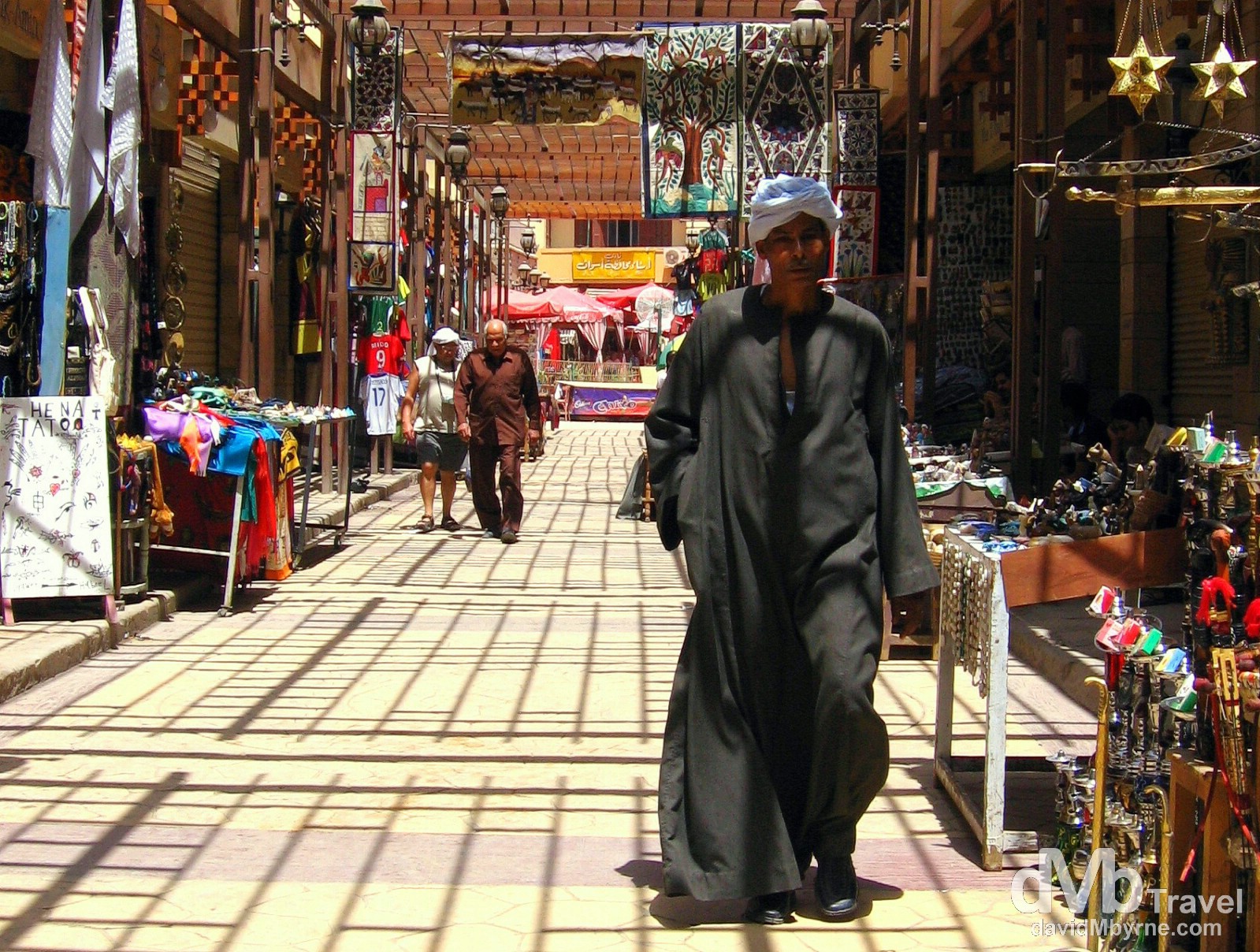
In Luxor’s open-air As Souq, the place when in town to pick up the usual nick-nacks and tourist detritus – anything from jewellery, to sheesha (water pipes), to camel-hair carpets to silk scarves. Just remember to haggle. Hard. Luxor, Egypt. April 11, 2008.
______________________________________________________________________
Valley of The Kings (& Queens)
______________________________________________________________________
Egypt’s principal tourist lure remains, as ever, the Nile Valley that stretches south from Cairo, a valley famous for its ancient monuments and timeless river vistas. The train we took from Cairo’s Ramses Station a few nights ago followed this fertile valley, about the only fertile part of an overwhelmingly stark desert country, south to Luxor. It was here, starting in around 1500 BC, that Egyptian Kings (known to you and I as Pharaohs) of the so-called New Kingdom period of Egyptian history (16th to 11th centuries BC) shunned the pyramid building burial techniques of their Old Kingdom (circa 27th to 22nd centuries BC) predecessors, choosing instead to be buried in secretive tombs hewn into rock, believing them to be less susceptible to the tomb robbing/looting. We now know the location they chose was a small, barren and bone-dry valley in the Theban hills on the west bank of the Nile across from Luxor proper, today known as The Valley of the Kings. It was chosen due to its relative isolation and proximity to the then Egyptian capital Thebes, modern day Luxor. The valley, a natural sun trap surrounded by limestone crags, houses over 60 tombs (not all for Pharaohs), tombs that were designed to resemble the underworld – a long inclined, rock-hewn corridor descends into either an antechamber or a series of halls ending at a burial chamber. These secretive tombs were intended as the ultimate insurance policy on life eternal; the plan was to preserve the Kings mummy and funerary finery for eternity. However, all didn’t quite go to plan and as with the pyramid tombs before them the valley tombs fell foul of large scale tomb-robbing. This coupled with ongoing excavations (which first began in the 1830s but reached their height in the early decades of the 20th century) and discoveries, specifically that of the tomb of the child Pharaoh Tutankhamen by English archaeologist Howard Carter in 1922, has turned the site into the mass tourist circus it is today, complete with toy train, frustrating pricing & photographic restrictions.
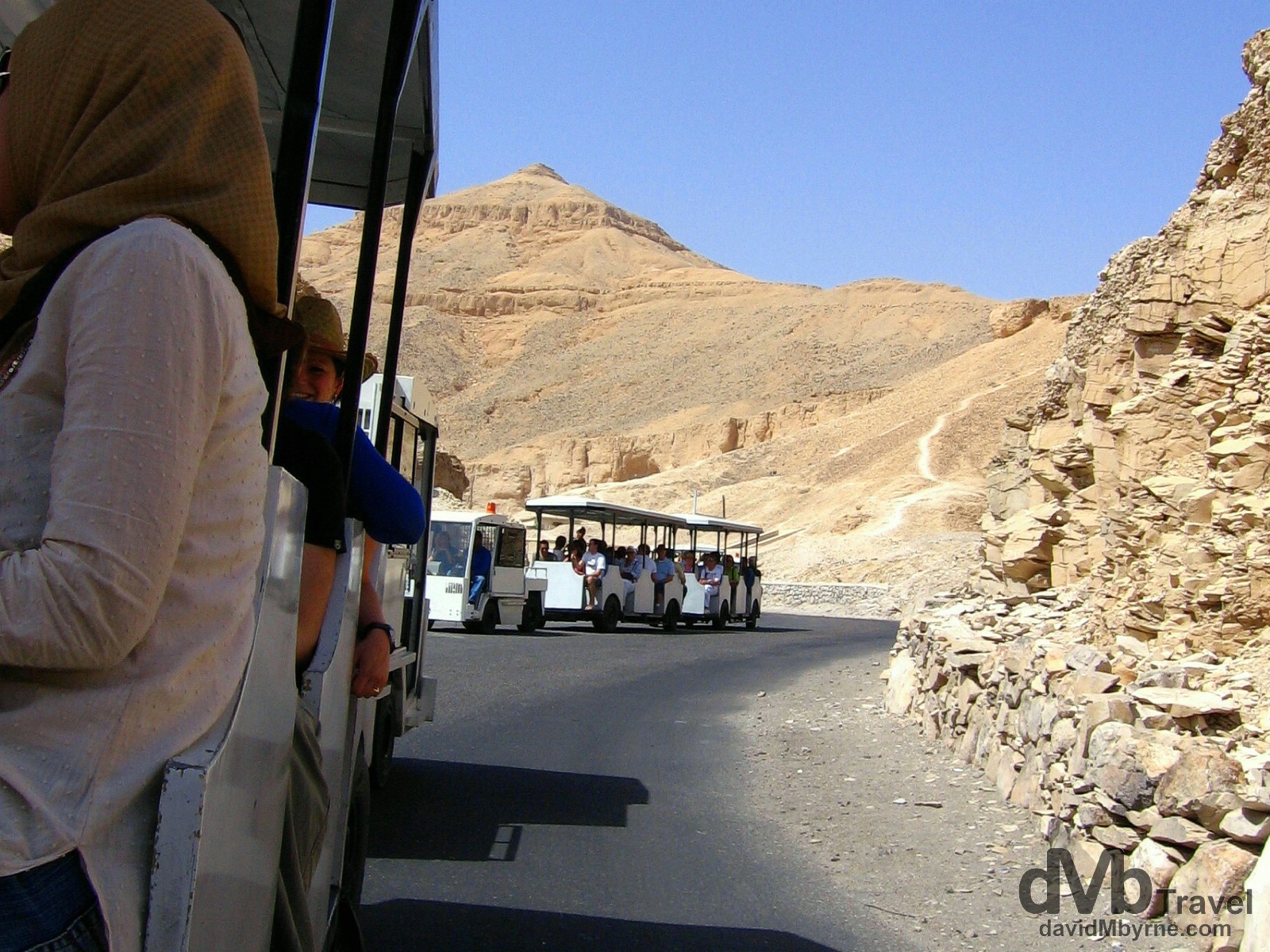
Riding the (compulsory) tourist train into The Valley of the Kings. The entrance to the small valley, about 1 kilometre from the tombs proper, contains a tourist centre/bazaar, a cloakroom for stashing video cameras (amazingly there is no fee) & the ticket office where you must purchase not one but two tickets – one for entrance into the valley itself and one for the amusement park-esque train seen here (talk about being taken for a ride) that shuttles tourists up a serpentine road (known as Biban el-Melouk, “Gates of the Kings” in Arabic) that follows the route of ancient funeral processions. The Valley of the Kings, West bank of the Nile, Luxor, Egypt. April 12, 2008.
Tomb Exploration || Then & Now
The exploration of tombs in the Valley of the Kings began in earnest with a series of excavations sponsored by Theodore Davis in 1902-14, a period in which more than thirty tombs and pits were cleared. However, it was the 1922 discovery of Tutankhamen’s tomb that made headlines around the world and put this place firmly on the map. Excavations continue today and as recently as 1995 a mass tomb for the sons of Ramses II was uncovered beneath tomb #5, long regarded as empty. Today of the 64 tombs uncovered (numbered in order of their discovery) barely a dozen are open at any one time. Most visitors find three to five tombs enough for one visit, which is just as well given the ticket you buy for the valley limits you to visiting just three tombs anyway, not including tomb #62, that of Tutankhamen – if you want to visit that you have to, of course, pay extra. A lot extra. We visited tomb #2 (Ramses IV), tomb #16 (Ramses I) & tomb #11 (Ramses III), deciding that the fee to visit Tutankhamen’s tomb was excessive (it is). No biggie as seemingly it’s a letdown anyway – the best part of the tomb were the treasures it gave up, all of which we ogled over in the Egyptian Museum in Cairo a few days previous.
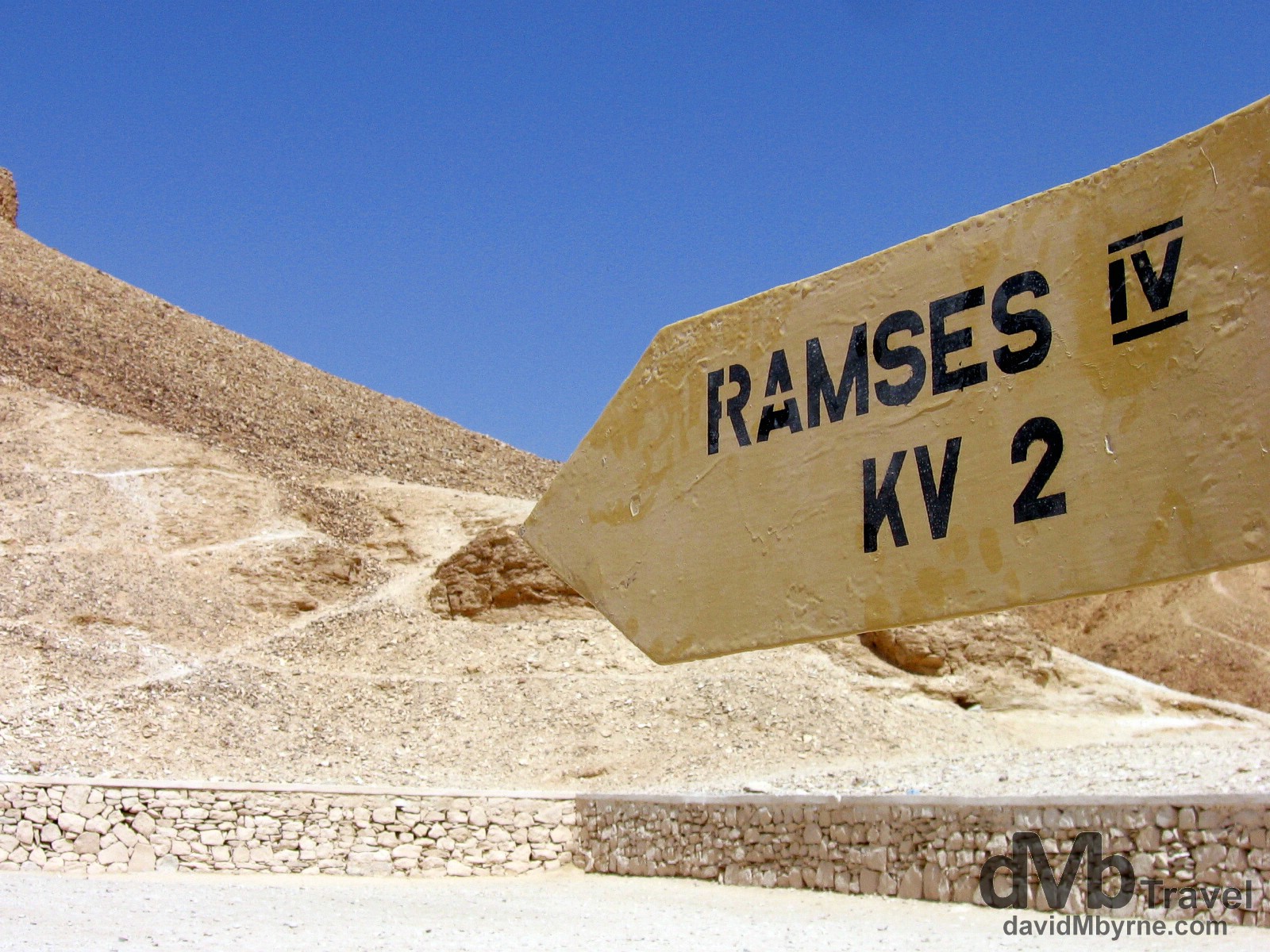
Of the three tombs we visited this, tomb KV2, the tomb of the Pharaoh king Ramses IV (ruled from 1155 to 1149 BC), was my favourite (photography isn’t allowed in any of the tombs thus you’re seeing a sign pointing to the tomb rather than the tomb itself). The dramatic shafts & phantasmagorical murals on the walls & ceilings of all the royal tombs vividly depicted the descent into the underworld, the judgement of Osiris (Egyptian God of the underworld and judge of the dead) and the rebirth of the pharaoh entombed within. However, it’s the 3500-year-old art work of Greek and Coptic graffiti in this tomb and its enormous pink-granite sarcophagus that make it the crowd-pleaser that it is (although as with all of the tombs, especially the deeper ones, the heat permeating the shafts and chambers, whose air is musty and humid, and the conveyor belt nature which you view the tombs make hanging around to truly appreciated the sight a slightly uncomfortable experience). On the sarcophagus of the tomb are magical texts and carvings of Isis (Egyptian goddess of fertility) and Nephthys (Egyptian goddess associated with ritual of the dead) to protect the mummy from harm. When these seemed insufficient, the priests stashed Ramses in the tomb of another pharaoh, Amenophis II (tomb #35), whence the now empty sarcophagus has been returned. These days the mummy of Ramses IV is in the Egyptian Museum in Cairo, a mummy that shows him to have been a short, bald man with a long nose. The Valley of the Kings, West bank of the Nile, Luxor, Egypt. April 12, 2008.
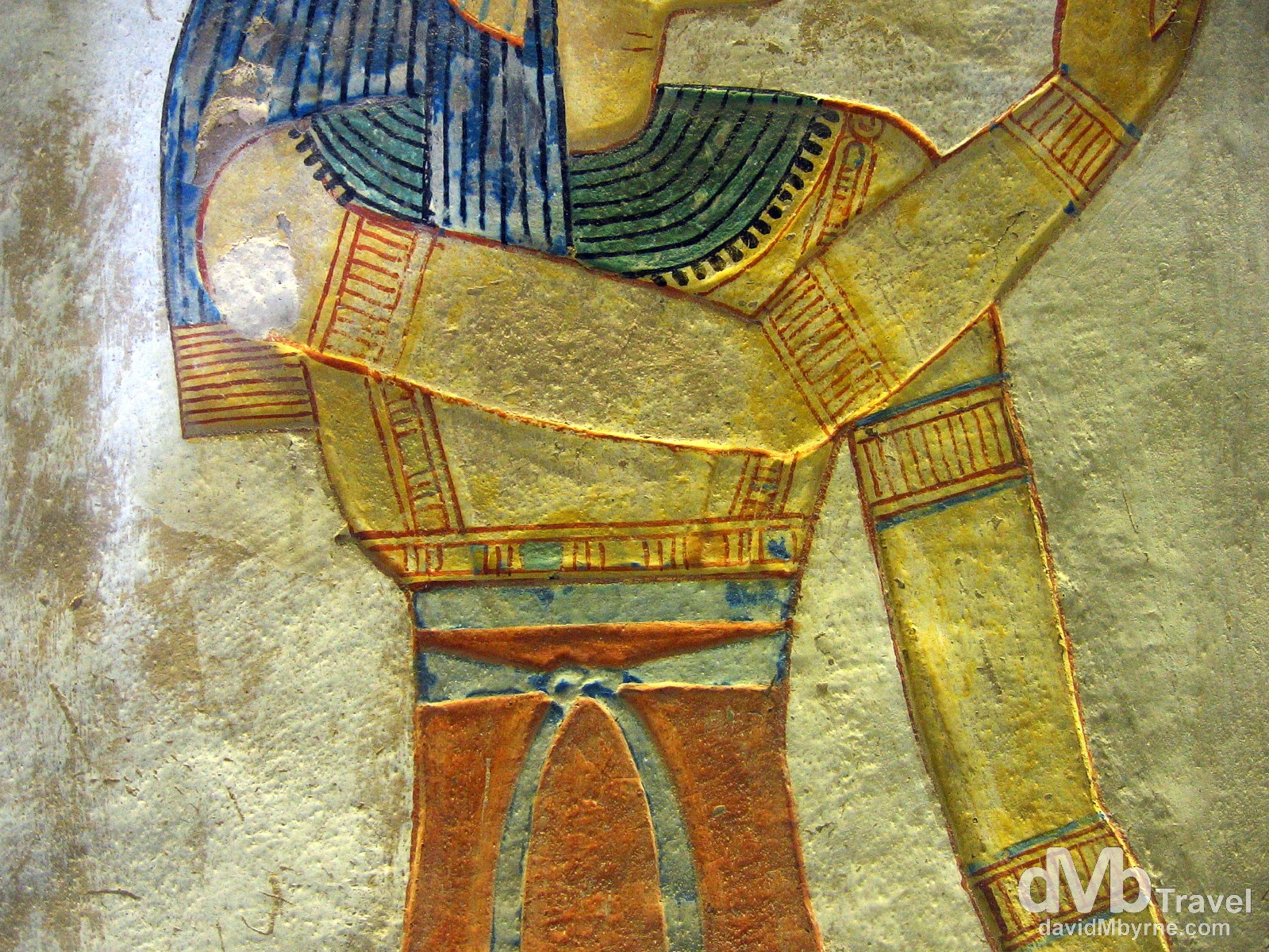
A picture of artwork protected behind glass in a tomb in The Valley of The Queens near the Valley of the Kings, a smaller valley where the Pharaoh wives and other royal family members were buried. Photography wasn’t allowed in here either but the tomb guardian was so preoccupied with lining his pockets by offering unnecessary services to other tomb visitors that I managed to sneak this picture, the only one I was able to capture in any of the tombs we visited on the day. By the way, no ancient artworks were harmed in the capturing of this picture – my flash was off. The Valley of the Queens, West bank of the Nile, Luxor, Egypt. April 12, 2008.
______________________________________________________________________
The Funerary Temple of Hatshepsut
______________________________________________________________________
After the Valleys (of the Kings & Queens) it was off to visit a temple.
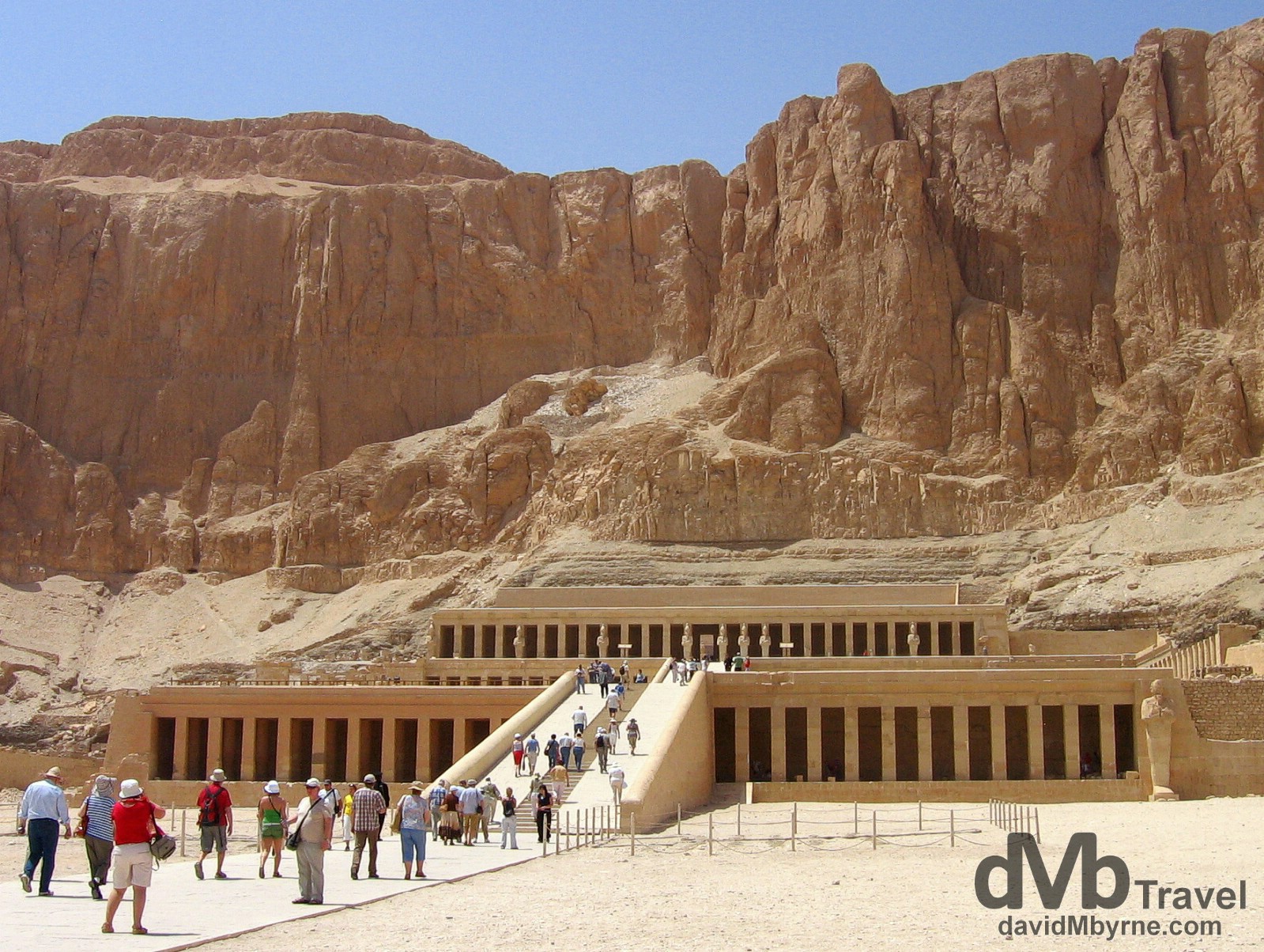
The Funerary Temple of Hatshepsut is a structure that rises out of the desert plains in a series of terraces and merges with the sheer limestone cliffs of the mountain behind it. Hatshepsut, meaning ‘Foremost of Noble Ladies’, was the 5th Pharaoh of the 18th dynasty of Ancient Egypt, ruling from 1479 BC to 1458 BC. She is generally regarded by Egyptologists as one of the most successful Pharaohs reigning longer than any other woman of an indigenous Egyptian dynasty. Her temple was desecrated and vandalised by her bitter successor, Tuthmosis III, but retains much of its original magnificence. It is an amazing sight from afar. The Funerary Temple of Hatshepsut, West Bank of the Nile, Luxor, Egypt. April 12th 2008.
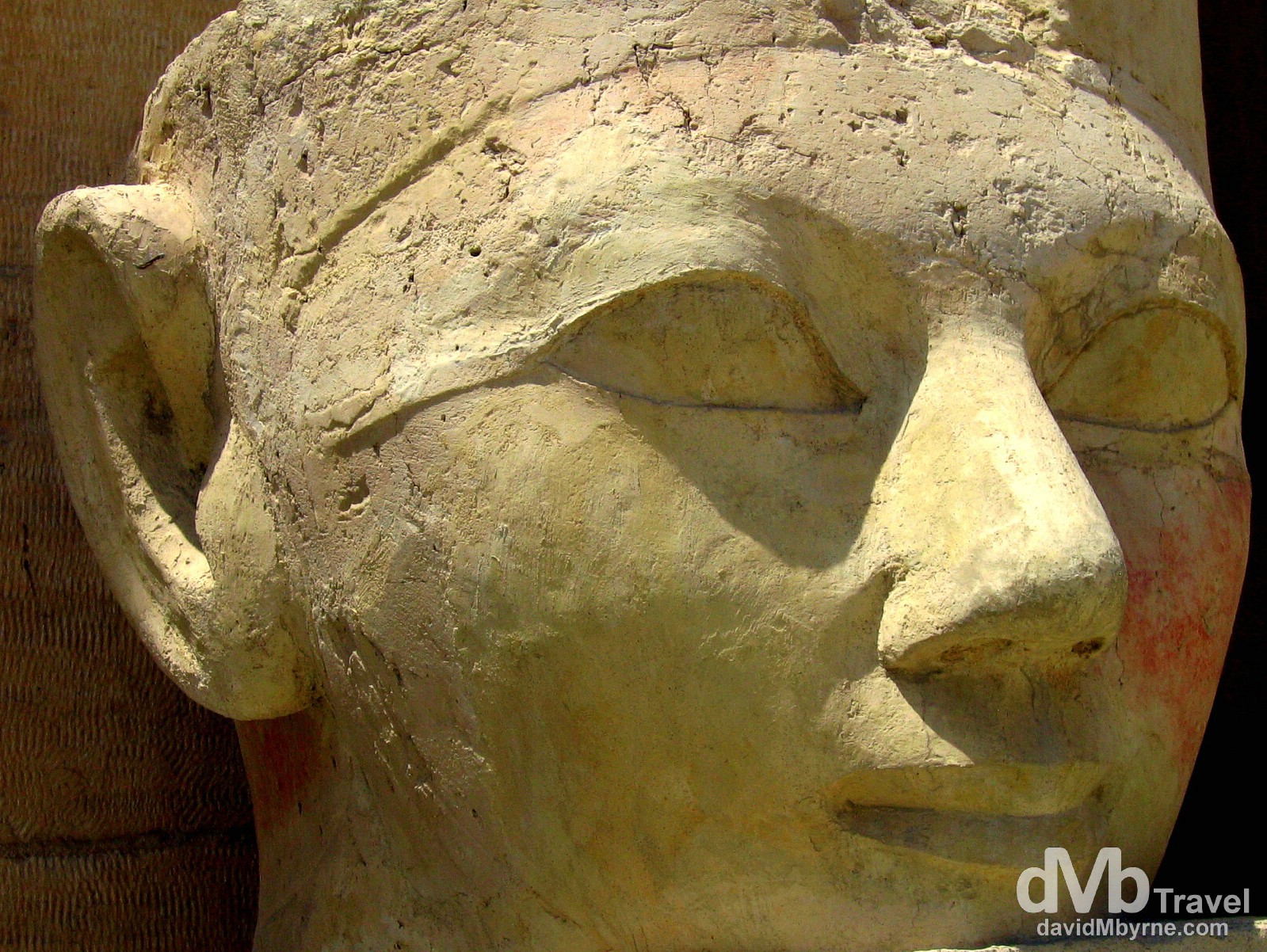
A statue head resembling Hatshepsut at the Hatshepsut temple. The symbols of her pharaonic power – the Uraeus (a stylized, upright form of an Egyptian spitting cobra used as a symbol of sovereignty, royalty, deity, and divine authority in ancient Egypt), a Double Crown, and traditional false beard – have all been stripped from this statue and many of the other statues in the temple. Many of the temple images portraying Hatshepsut (paintings and statues) were destroyed or vandalized within decades of her death, possibly by her bitter successor, Tuthmosis III, in order to assure his own rise to Pharaoh and then to claim many of her accomplishments as his. The Funerary Temple of Hatshepsut, West Bank of the Nile, Luxor, Egypt. April 12, 2008.
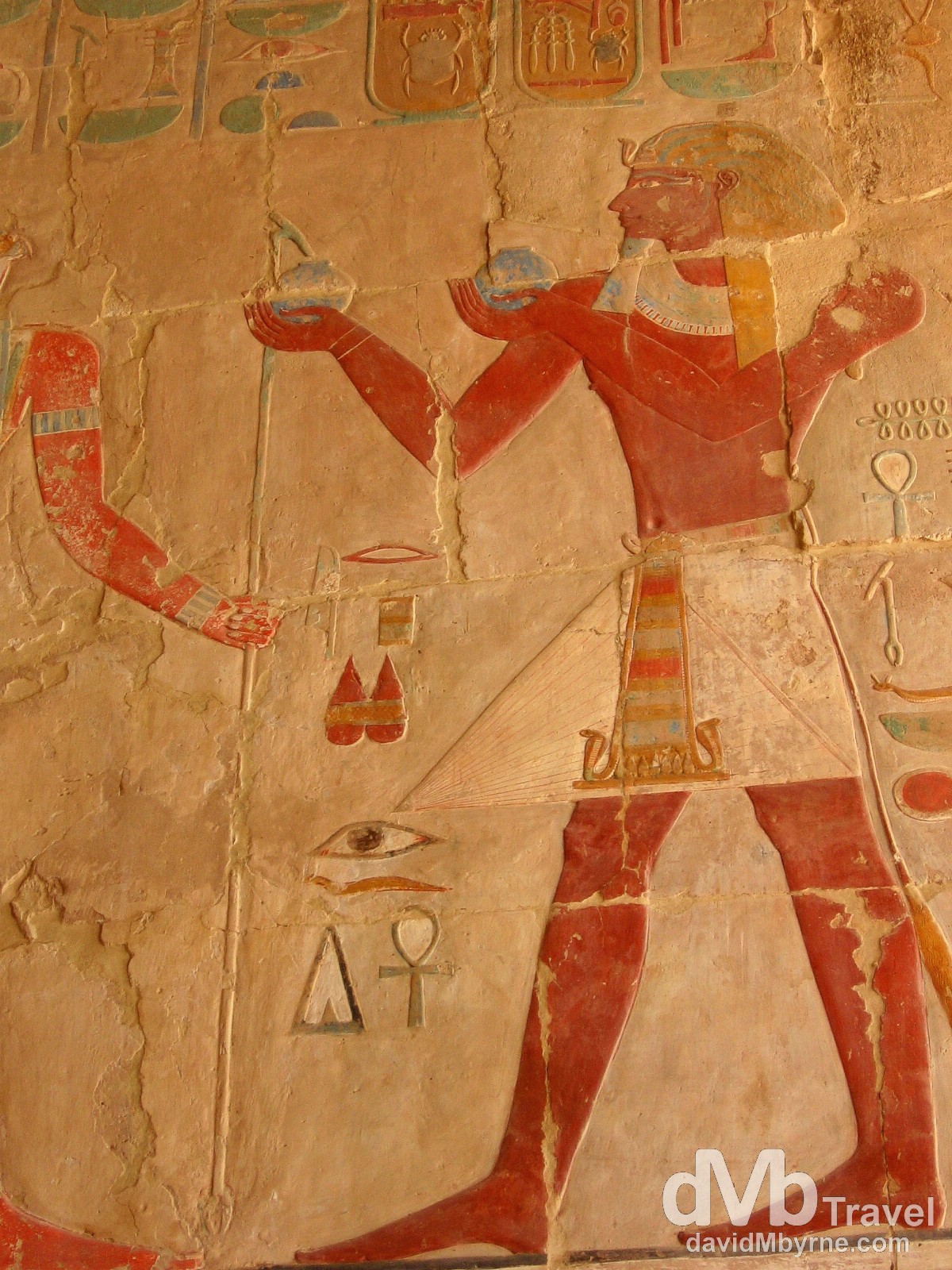
Ancient Egyptian symbols on the walls of the Funerary Temple of Hatshepsut. Some of the more common Egyptian symbols are seen here including the Flail & Crook, a symbol of royalty, majesty and dominion, the Ankh, a symbol of eternal life, and the Scarab, also called the dung beetle because of its practice of rolling a ball of dung across the ground. The Egyptians observed this behaviour and equated it with the ball of the sun being rolled across the sky. They confused this balled food source with the egg sack that the female dung beetle laid and buried in the sand. When the eggs hatched the dung beetles would seem to appear from nowhere, making it a symbol of spontaneous creation. In this role it was associated with the sunrise. The Funerary Temple of Hatshepsut, West bank of the Nile, Luxor, Egypt. April 12, 2008.
______________________________________________________________________
Baksheesh || Tourist Tax
When visiting sites in Egypt you are always being offered subtle and unnecessary services by the site guardians in return for a tip, called baksheesh. We try to avoid such situations but I was unable to avoid the so-called guardian in the below picture while in The Funerary Temple of Hatshepsut. He beckoned me to take a look at something I shouldn’t be looking at beyond the off-limits ropes he is walking towards in the picture.
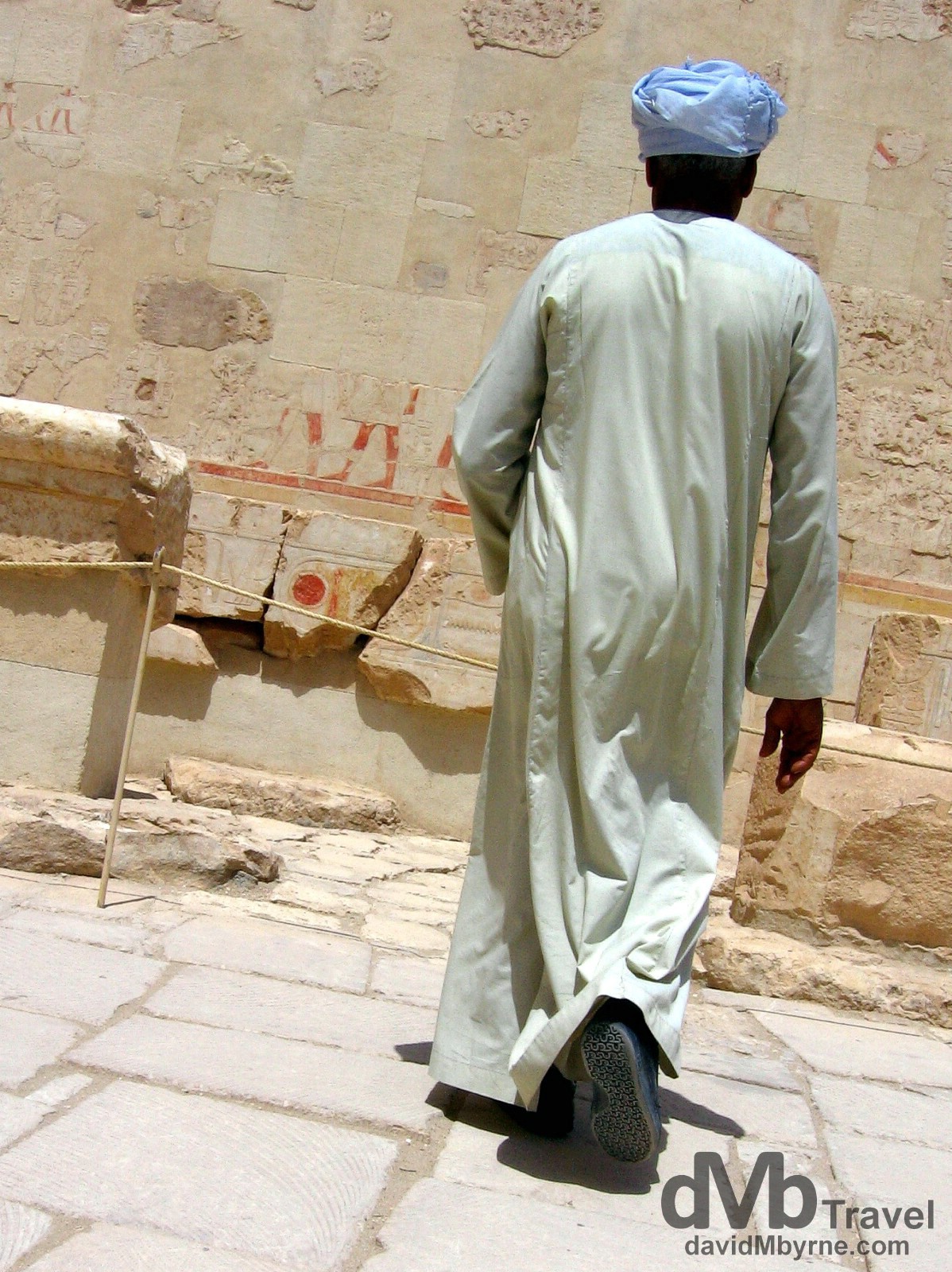
Baksheesh in The Funerary Temple of Hatshepsut, West Bank of the Nile, Luxor, Egypt. April 12, 2008.
I knew whatever it was he wanted me to see 1) probably wouldn’t impress me all that much, and 2) would cost me to view anyway. I was right on both counts. A quick glimpse at some rather amateurish looking hieroglyphics saw me rewarding him for his service a rather generous 10 Egyptian pounds (€1.20). I was taken aback when he then demanded I give him 20 pounds. What he received was a stern look. According to my guidebook tipping is 1) ‘a way of life in Egypt’ (something you won’t need a guidebook to know once you get here); 2) that ‘you are expected to tip, conventions for which are byzantine’; and that (3 ‘a guard who shows you something off the track at an archaeological site should be given a pound or two.’ A pound or two. The book also states that for western travellers, who are not used to continual tipping, the expectation of a monetary reward for doing anything from opening doors to pointing out the obvious at a tourist site can be ‘quite irritating’ before going on to recommend that you not be ‘intimidated into paying baksheesh when you don’t think the service warrants it,’ all the while remembering that ‘more things warrant baksheesh here than anywhere in the West.’ Too true. Too very true.
______________________________________________________________________
Luxor || What (Else) To Do?
______________________________________________________________________
Being here in Luxor isn’t all about forking over money to stand in a line with dozens of other sweaty tourists collectively snaking your way in and out of 3500-year-old tombs & admiring/trying to decipher ancient hieroglyphics as you go. Nope, there are quite a few attractions, for want of a better word, on the streets of the town itself and they won’t cost you a cent to see them. Luxor is generally a quiet and peaceful affair and offers a nice reprieve from chaotic, cacophonous Cairo. That is until you find yourself dealing with the town’s back streets, back streets that would rival those of the worst war-torn streets anywhere in the world and back streets only yards from the international 5-star hotels lining the Nile waterfront. It’s quite an eye-opener but just don’t open them too wide else you’ll be making your baby blues susceptible to damage by some nasty dust. Old, nasty dust.
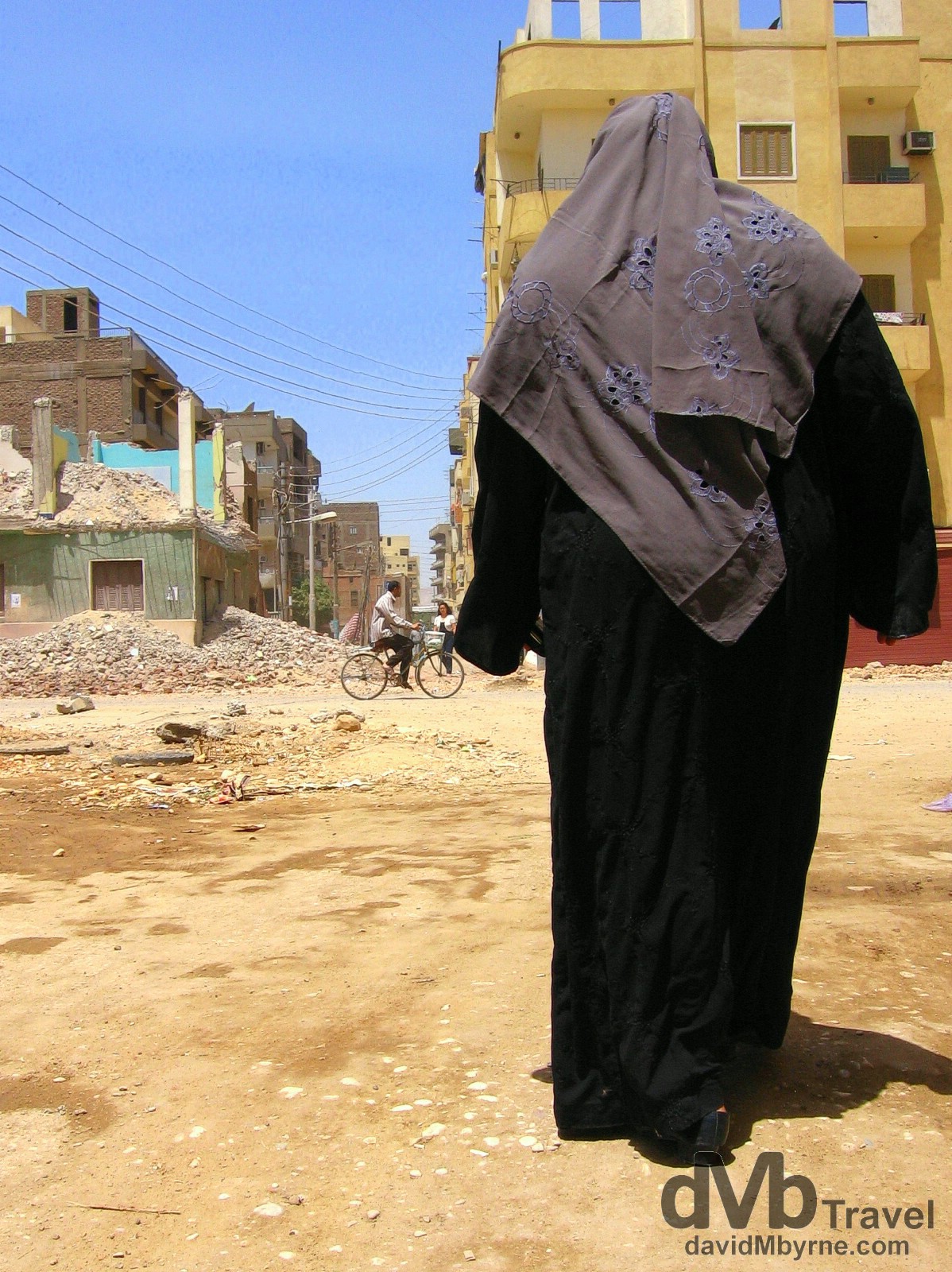
Walking the crumbling, almost shambolic, war torn-esque streets of Luxor is as much of a must-do in Luxor as visiting the Valley of the Kings. Mohammed Farid, Luxor, Egypt. April 11, 2008.
Other than rubble, valleys, tombs & dust there are also temples here, including The Luxor Temple.
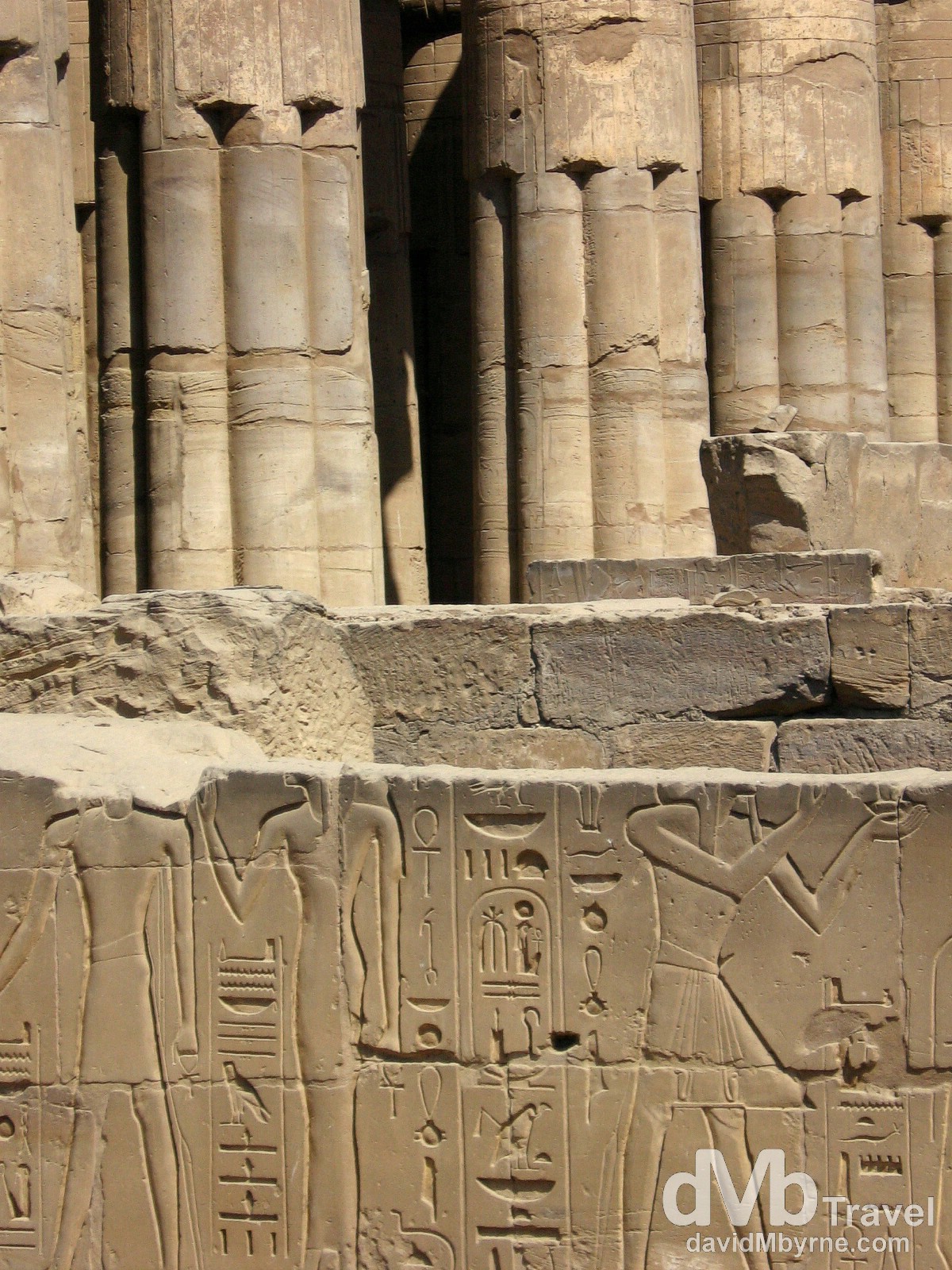
The Luxor Temple, situated on the banks of the Nile, is a large temple complex, a strikingly graceful piece of ancient Egyptian architecture that proved to be quite photogenic. Founded in 1400 BC, it was largely built by a Pharaoh called Amenhotep III but it was added to over the centuries by others, including Tutankhamen – Alexander The Great and a few Romans also added to it over the years. There’s not much of the structure left today, just a few towering columns (actually, quite a few towering columns) and a few walls with hieroglyphics as seen in this picture. The Luxor Temple, Luxor, Egypt. April 11, 2008.
Not too far from The Luxor Temple is the small Mummification Museum, one that houses a few rather strange mummies (not just of humans) but one that doesn’t really explain the fact that mummies are embalmed bodies, dried and wrapped for burial and presentation to Orsis, the ancient Egyptian King of the underworld whose approval was required to attain the afterlife. And last but by no means least there is of course the 6,700 kilometre Nile River, only the longest river in the world.
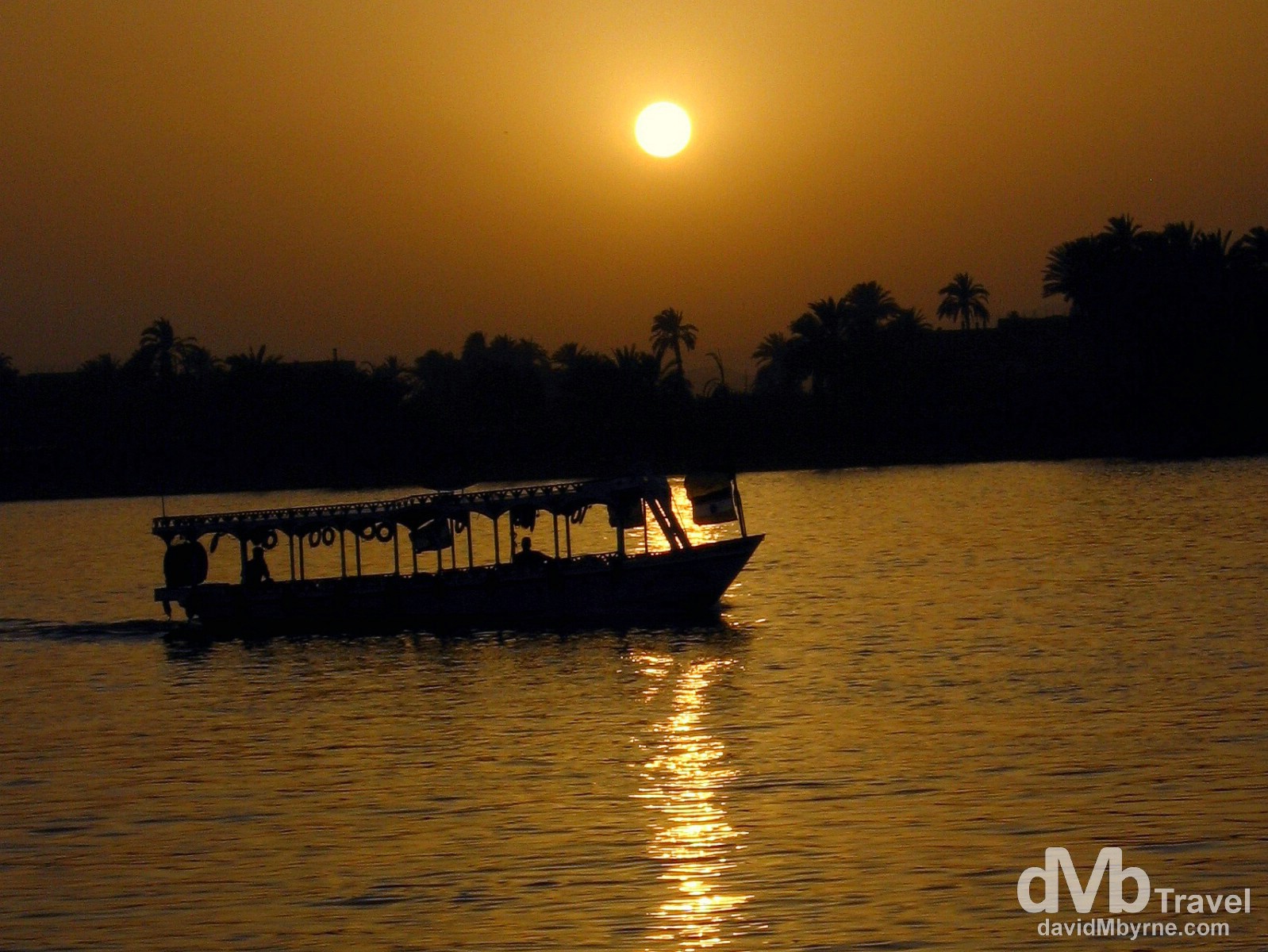
Sunset on the Nile River. A cruise on the Nile, romantic or otherwise, is the de rigueur activity in this part of the world. Needless to say options abound for doing so with any one of an armada of Nile cruise ships and felucca sailboats (a fast narrow sailing ship of the Mediterranean) lining Luxor’s riverfront promenade, the Corniche el-Nile, from where this picture was captured. Luxor, Egypt. April 12, 2008.
______________________________________________________________________
Pharaonic Fatigue
We’re now back in the rooftop terrace of the Nubian Oasis Hotel relaxing, recovering from pharaonic fatigue and doing what we do best; sipping a few more Stella beers ahead of our 11 p.m. train departure for the return to Cairo. Cairo, Part II. At least we’ll know what to expect from our next port of call in the country, a comforting first for us in Egypt.
______________________________________________________________________
Luxor Observations
______________________________________________________________________
· A (Peacetime) War Zone
There are no two ways about it; beyond the touristy, and nicely paved 5-star-hotel-frequenting Nile riverbank & downtown open-air souq, Luxor is a crumbling, dilapidated mess, one that looks like it has been crumbling since long before Pharaohs roamed the area. The back streets of Luxor resemble a war zone; paved roads are non-existent and buildings & walls lay in piles of rubble beside erect buildings that, although still standing, look like a stiff breeze would topple them into yet another pile of rubble. Walking the streets of Luxor reminded me of my visit to the town of Fengdu as part of a Yangtze River cruise in China some years ago, a town that at the time was being dismantled ahead of the rise in the Yangtze River water level due to the construction of the Three Gorges Dam. No such excuse here, or at least none we’re aware of.
· An Unnecessary Extravagance
I mentioned in the previous entry how we opted to travel to and from Luxor in the cheaper 1st class seating train, shunning the special, and far more expensive (€45 expensive), so-called tourist sleeper train in the process. Well, we can now report that the tourist sleeper train is, in our opinion, an unnecessary extravagance; we both slept well on the 1st class seating train coming down here, even if the carriages and the seats in those carriages have their best days well and truly behind them. Here’s hoping the return journey tonight will be as painless.
· “Australian?… Lebanese?”
We’re still hearing the “where are you from?” question dozens of times a day. It’s only slightly annoying at this stage but only because the touts down here in Luxor are a little bit more presumptuous than their northern brethren, going so far as to answer their own questions.
“Where you from?… England?” is invariably their first choice. A shake of the head from us gets them guessing again.
The leading vote-getter for the where are we from guesses so far is Australia for me and Lebanon for an obviously darker and Mediterranean-looking Pat. When we finally reveal (and convince) them that we are both Irish, we then have to enlighten them that it (Ireland) is a small island beside England and that Pat’s mother is of Mediterranean extraction. That conversation only serves to temporarily delay the onset of the sales pitch.
· Second Thoughts
We had planned on cycling to and around the sights of Luxor but once we got here we realised that wasn’t a very good, self-preserving idea; the distances between the sights coupled with the midday heat would have made for an exhausting day on a bike. So we found ourselves being ferried to and from The Valley of the Kings, The Valley of the Queens & The Funerary Temple of Hatshepsut inside the relative comfort of an air-conditioned minibus, one we shared with our guide & 7 other tourists, two of which were an Egyptian couple on their honeymoon. Nice.
· For Your Safety
It’s unfortunate to say but there is an ever-present, albeit slim threat of an Islamic uprising in Egypt. That explains why 1) there are travel restrictions in place for foreigners travelling around the country, & 2) there are an abundance of gun wielding guards – The Tourist and Antiquities Police – at most Egyptian tourist attractions, especially the sites here in Luxor. They are there to protect both the tourist and the Egyptian tourist industry, Egypt’s biggest money earner by far and an industry that is still trying to recover from the fall-out from the 1997 massacre of 58 tourists at the Funerary Temple of Hatshepsut, the very same temple we visited today.
· R + P’ing
35 Egyptian pounds (€4.25) for a nice room with breakfast in the Nubian Oasis Hotel is more like the prices we were hoping to pay in Egypt, and a third of the price we paid for far less accommodating accommodation in Cairo. It’s just a pity the surrounding neighbourhood is such a mess.
· Who Exactly is R & P’ing Who?
Okay, I don’t want to dwell too much on the frustrations we experienced as two independent travellers to Luxor (and Egypt thus far) but I do still want to mention them all the same. They, the frustration, not surprisingly all revolve around money and the ever-present efforts of the locals to relieve you of as much of it as possible. It leaves us wondering who exactly is raping & pillaging who. Take out of whack pricing for example. To us at least it doesn’t seem right when you can snare a nice, albeit basic, hotel room (or ANY hotel room for that matter) for EGP35 (€4.25) but then you’d be hard pressed to find a dish (ANY dish) in a restaurant (yep, ANY restaurant) for less than EGP30. That says nothing for the price of a few beers which leaves us in no doubt that the homeless of Luxor are definitely not alcoholics. Looking to buy water? The price for the same bottle will vary from shop to shop and stall to stall and you will always have to haggle for what you deem to be a fair price, although only with stall owners – the shops, where haggling isn’t tolerated, will just shamelessly overcharge you. Oh, and don’t forget to check your change, assuming you actually get change.
Other frustrations we’ve experienced involve visiting the tourist sights, sights that invariably don’t allow you to take pictures (hence the reason for the lack of pictures from any of the tombs in The Valley of the Kings in this entry and the lack of pictures from the Egyptian Museum, Cairo, in the last entry); sights that charge you hidden dual entry fees – if you want to see the so-called highlight of The Valley of the Kings (Tutankhamen’s Tomb) or The Egyptian Museum (The Mummy Room) then you’ll have to pay extra, typically a lot extra, once you’ve paid the standard entry fee; sights that are manned by locals who expect high tips for unnecessary services, such as guiding you to a seemingly interesting, off-limits area of a temple or illuminating a low-lit tunnel in a tomb with a flashlight. Yep, we’ve only 4 days of Egypt under our well travelled-belts and already the frustrations are adding up. With more of the country’s ‘limitless’, to quote Lonely Planet, treasures to come we can only imagine the frustrations will continue.
______________________________________________________________________
